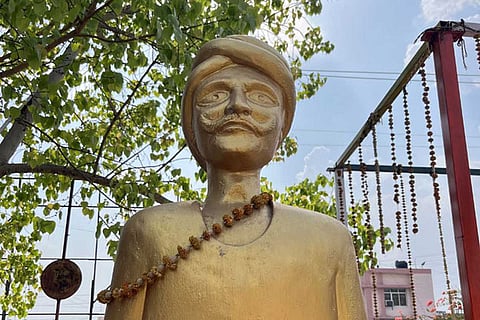On Ramji Gond’s martyrdom anniversary, a retelling of the 19th-century legend
The legend of Marsukola Ramji Gond continues to be perpetuated over many decades, but his origins remain shrouded in mystery. This aboriginal Gond from present-day Adilabad district in Telangana is believed to have led the only rebellion by tribals against the British during the First War of Independence in 1857.
Ramji Gond, a leader of the Raj Gonds — an aboriginal tribe in Adilabad district — was at the head of a rebel force of a thousand soldiers, according to the 1976 edition of the Adilabad District Gazetteer. The force also included Rohillas — Afghan Pathans who had settled in Uttar Pradesh’s Rohilkhand and had fought in the First War of Independence under the leadership of Nana Saheb Peshwa II. These rebels were eventually captured and hanged from a banyan tree just outside of Nirmal town, in the neighbouring Nirmal district. This huge tree, which came to be known as ‘Veyyi Urula Marri’ or the banyan of thousand nooses, had symbolised the saga of the rebels until it fell down about two decades ago.
A martyrs’ column has since been erected at the spot. Tribals and politicians of all hues go there once every year to participate in the martyrdom anniversary. Native tribals consider Marsukola Ramji to be their icon and want the present-day government to observe his martyrdom anniversary on April 9. This is the date on which the first of the hangings are believed to have been carried out by the British in 1860, though records show that the Gond warrior himself was hanged only later that year.

The martyrs' column in Nirmal
Well-known economist and columnist Mohan Guruswamy, who evinces a keen interest in tribal matters, quotes from a report published in the Daily Englishman on October 27, 1860, as he sheds light on the events of those tumultuous times. His article on the subject quotes the Hyderabad Affairs, Vol.III, 1883, and traces the date of Marsukola Ramji’s death to sometime before October 15, 1860.
But who was Marsukola Ramji and where did he come from? He was definitely not a clan chieftain or a king, as no song or ballad of the Marsukola clan mentions him.
At best, he was a village headman or patel of Adilabad who perhaps hosted the fleeing Rohillas when they sought help in resisting the British, who were coming after them from Hyderabad. Marsukola elders affirm that Ramji belonged to Edlapur, the original name of present-day Adilabad town, to which the entire clan originally belongs.
At some point in time, perhaps as a result of the British onslaught on the tribals, the clan abandoned Edlapur and settled in Ankapur near Ankoli in Adilabad Rural mandal. Members of the clan from this village went on to establish the Lohara village about 25 km from Adilabad town, while a few others settled in Gundala in Narnoor mandal.
As per the Gond tribe’s customs, all families and individuals, no matter how far they live from each other, need to identify their ‘vatun’ or place of origin during formal introductions on occasions such as weddings.
As present-day Adilabad town is the vatun of the Marsukola clan, even Ramji would have identified himself with it, observes Marsukola Govind, a resident of Ankapur village.
As proof of Adilabad being their place of origin, the Marsukola clan cites the presence of a temple denoting the resting place of ‘Bada Dev’ or ‘Persa Pen’. While Persa pen is believed to be spirit with no definite resting place, the Raj Gonds customarily safekeep the ‘salle’ — a sacred piece of iron believed to be a part of the Persa Pen — on a mahua tree. Other parts, such as the ‘chahur’ or fly-whisk, the ‘ghaghra’ or bells, and the ’kati’ or bamboo handle, are kept in a sacred pot in the Bada Dev temple. Today, this temple is located within the premises of the Sri Ramachandra Gopala Krishna Math. However, members of the Marsukola clan say their temple predates the 400-year-old math and is unrelated to it.
There are a few Rohilla families settled in Adilabad town and in Gudihatnoor mandal besides Jainoor town. They do not have any clue about their origins, and over the years, they have sort of merged into the local community. Abdul Rauf Khan, the eldest of Rohillas in Adilabad who lives in Dongargaon in Gudihatnoor mandal, does not remember his parents or grandparents discussing their origins.
As regards the Gond-Rohilla uprising against the British, the skirmishes or guerrilla war continued for two years until October 1860. The Adilabad District Gazetteer says the ‘rioters’ would concentrate a few miles away from Nirmal, where the tract was not easily accessible to the British forces. Back then, Nirmal was an important outpost for the Britishers, and that was presumably the reason for the rebels to carry out their ‘struggle’ near this place, about 80 km from Adilabad. The terrain would have been too difficult, as is evident from the rocky hillocks surrounding the town, to wage a protracted struggle.
In 2021, the Telangana Ministry for Tribal Welfare had announced that it would set up a memorial museum to honour Ramji Gond, with support from the Union government.

Union Minister G Kishan Reddy honouring Ramji Gond’s memorial in 2007
All images by Harpal Singh.
S Harpal Singh is an independent journalist who has reported mostly on environment and tribal issues for various newspapers in Telangana for 34 years. He worked as the Senior Assistant Editor from Adilabad district for The Hindu from 2004 to 2020.

